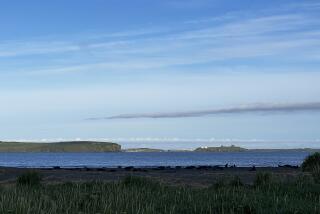As Sovereignty Vote Nears, a Look at Virgin Islands’ Sometimes Rocky Ties to U.S.
- Share via
ST. CROIX, U. S. Virgin Islands — On a morning-bright veranda overlooking Christiansted Harbor, Donaldo Abramson sips coffee and recalls how it was to be among the first people on the first day of every year to see the sun charge up from the dark ocean and shine on U.S. soil.
“We’d usually go out there to the head of the island around 4 in the morning on New Year’s Day and make a sort of a picnic,” said Abramson, now 65 and manager of a hardware store. “We all were young, and we thought it was a good thing to see the sun come up first thing in the year, rising up out of the water . . . that beautiful sight.”
A tropical sunrise in mid-winter is one reason 1.9 million tourists came last year to these islands, which include St. Croix’s Udall Point, the easternmost tip of U.S. territory in the Atlantic.
But the United States is only the latest landlord. The flags of six nations have flown over the islands since Christopher Columbus discovered them during his second voyage to the New World in 1493. And next November, the islands’ 106,000 residents will vote on whether Uncle Sam’s 72-year-old stewardship is to their liking.
Virgin Islanders will be offered seven choices of status, from remaining unincorporated U.S. territory to independence.
“We have never really been given a chance to say what we want to be,” says Marilyn Krigger, co-chair of the commission appointed to oversee the referendum.
These specks of land, which Columbus named for St. Ursula’s legendary 11,000 virgins, have been dominated by foreigners ever since Columbus captured several Carib Indians in the vicinity.
No match for Spanish steel and diseases, the Caribs soon were wiped out. Much of today’s native population is descended from West Africans brought over as slaves for Dutch sugar planters in the 17th Century. There are also numerous immigrants from nearby Puerto Rico and many American mainlanders who came to the islands in search of peace, adventure or opportunity, and stayed.
The islands have been controlled at different times by Spain, France, Holland, England and Denmark. During one 14-year period in the mid-17th Century, the Knights of Malta administered St. Croix on behalf of the French.
Denmark colonized the area as early as 1672, and has left permanent marks on the architecture and culture. In 1917, the United States paid Denmark $25 million for St. Thomas, St. Croix and St. John. American leaders had wanted a naval base in the Caribbean since the Civil War.
The early days of U.S. ownership were not very happy. Islanders complained of high-handed treatment from the Navy bureaucrats who administered the territory for the first 14 years.
President Herbert Hoover reflected Washington’s attitude when, after a brief visit to St. Thomas in 1931, he declared that the United States had acquired “an effective poorhouse.”
Nevertheless, Hoover acknowledged an obligation to the islanders. In 1931, he transferred control to the Interior Department. In 1970, Congress allowed islanders to elect their own governor and, two years later, a nonvoting delegate to Congress. A territorial legislature handles local affairs.
Thus far, the prospect of choosing a new form of government has not stirred much enthusiasm, although commission members believe interest will grow as the advisory referendum approaches. A vote for anything close to independence seems unlikely to most observers, who doubt that islanders will choose to end or sharply reduce the substantial federal benefits they receive.
One of the choices is commonwealth status, which has been adopted by two other U.S. possessions: nearby Puerto Rico and the Northern Mariana Islands in the Pacific. Two other Pacific dependencies have chosen independence: the Federated States of Micronesia and the Republic of the Marshall Islands.
After the Virgin Islands’ referendum in November, a runoff between the two most popular choices will be held. Then the islands’ government will form a commission to draft a proposal to Congress. Any change in status would become law only after Congress and the President agreed on a plan.
More to Read
Sign up for Essential California
The most important California stories and recommendations in your inbox every morning.
You may occasionally receive promotional content from the Los Angeles Times.








